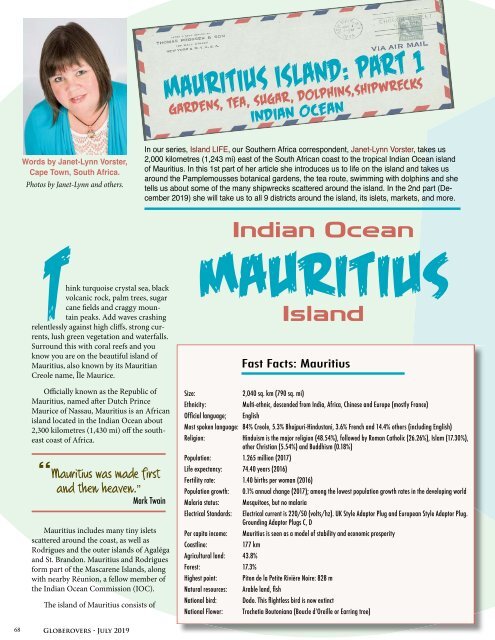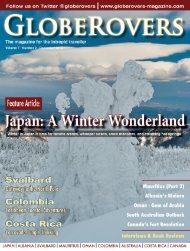Globerovers Magazine, July 2019
GLOBEROVERS MAGAZINE IS NO LONGER ALLOWED TO HAVE MORE THAN 3 ISSUES ON YUMPU UNLESS WE PAY (to provide revenue-generating content to Yumpu!!) SO PLEASE SEE ALL OUR ISSUES FOR FREE ON THESE MAGAZINE PLATFORMS: CALAMEO, MAGZTER, AND ON THE FREE "globerovers" APP. In this 13th issue (July 2019) of Globerovers Magazine, the feature destination is Argentina. We travel from the far north on the border with Bolivia all the way down south to Ushuaia, the gateway to the Antarctic Peninsula. We also have articles about Cyprus and Mauritius Island, Australia, Canada, and we enjoy a colourful New Year Festival with the Naga people in the remote Nagaland region of Myanmar. Photo Essays include the proboscis monkeys and orangutans in Malaysia’s Sabah State on Borneo Island, Peru’s Sacred Valley, and a boat trip down the Li River from Guilin to Yangshuo in China. Furthermore, we have traveller interviews, book reviews, and a lot more! Feedback to editor@globerovers.com. Enjoy!
GLOBEROVERS MAGAZINE IS NO LONGER ALLOWED TO HAVE MORE THAN 3 ISSUES ON YUMPU UNLESS WE PAY (to provide revenue-generating content to Yumpu!!) SO PLEASE SEE ALL OUR ISSUES FOR FREE ON THESE MAGAZINE PLATFORMS: CALAMEO, MAGZTER, AND ON THE FREE "globerovers" APP.
In this 13th issue (July 2019) of Globerovers Magazine, the feature destination is Argentina. We travel from the far north on the border with Bolivia all the way down south to Ushuaia, the gateway to the Antarctic Peninsula.
We also have articles about Cyprus and Mauritius Island, Australia, Canada, and we enjoy a colourful New Year Festival with the Naga people in the remote Nagaland region of Myanmar.
Photo Essays include the proboscis monkeys and orangutans in Malaysia’s Sabah State on Borneo Island, Peru’s Sacred Valley, and a boat trip down the Li River from Guilin to Yangshuo in China.
Furthermore, we have traveller interviews, book reviews, and a lot more!
Feedback to editor@globerovers.com. Enjoy!
Create successful ePaper yourself
Turn your PDF publications into a flip-book with our unique Google optimized e-Paper software.
Mauritius island: Part 1<br />
Gardens, tea, sugar, dolphins,shipwrecks<br />
Indian ocean<br />
Words by Janet-Lynn Vorster,<br />
Cape Town, South Africa.<br />
Photos by Janet-Lynn and others.<br />
In our series, Island LIFE, our Southern Africa correspondent, Janet-Lynn Vorster, takes us<br />
2,000 kilometres (1,243 mi) east of the South African coast to the tropical Indian Ocean island<br />
of Mauritius. In this 1st part of her article she introduces us to life on the island and takes us<br />
around the Pamplemousses botanical gardens, the tea route, swimming with dolphins and she<br />
tells us about some of the many shipwrecks scattered around the island. In the 2nd part (December<br />
<strong>2019</strong>) she will take us to all 9 districts around the island, its islets, markets, and more.<br />
Think turquoise crystal sea, black<br />
volcanic rock, palm trees, sugar<br />
cane fields and craggy mountain<br />
peaks. Add waves crashing<br />
relentlessly against high cliffs, strong currents,<br />
lush green vegetation and waterfalls.<br />
Surround this with coral reefs and you<br />
know you are on the beautiful island of<br />
Mauritius, also known by its Mauritian<br />
Creole name, Île Maurice.<br />
Officially known as the Republic of<br />
Mauritius, named after Dutch Prince<br />
Maurice of Nassau, Mauritius is an African<br />
island located in the Indian Ocean about<br />
2,300 kilometres (1,430 mi) off the southeast<br />
coast of Africa.<br />
“Mauritius was made first<br />
and then heaven.”<br />
Mark Twain<br />
Mauritius includes many tiny islets<br />
scattered around the coast, as well as<br />
Rodrigues and the outer islands of Agaléga<br />
and St. Brandon. Mauritius and Rodrigues<br />
form part of the Mascarene Islands, along<br />
with nearby Réunion, a fellow member of<br />
the Indian Ocean Commission (IOC).<br />
The island of Mauritius consists of<br />
Indian Ocean<br />
Mauritius<br />
Island<br />
Fast Facts: Mauritius<br />
Size:<br />
2,040 sq. km (790 sq. mi)<br />
Ethnicity:<br />
Multi-ethnic, descended from India, Africa, Chinese and Europe (mostly France)<br />
Official language; English<br />
Most spoken language: 84% Creole, 5.3% Bhojpuri-Hindustani, 3.6% French and 14.4% others (including English)<br />
Religion: Hinduism is the major religion (48.54%), followed by Roman Catholic (26.26%), Islam (17.30%),<br />
other Christian (5.54%) and Buddhism (0.18%)<br />
Population: 1.265 million (2017)<br />
Life expectancy: 74.40 years (2016)<br />
Fertility rate: 1.40 births per woman (2016)<br />
Population growth: 0.1% annual change (2017); among the lowest population growth rates in the developing world<br />
Malaria status: Mosquitoes, but no malaria<br />
Electrical Standards: Electrical current is 220/50 (volts/hz). UK Style Adaptor Plug and European Style Adaptor Plug.<br />
Grounding Adaptor Plugs C, D<br />
Per capita income: Mauritius is seen as a model of stability and economic prosperity<br />
Coastline:<br />
177 km<br />
Agricultural land: 43.8%<br />
Forest: 17.3%<br />
Highest point: Piton de la Petite Rivière Noire: 828 m<br />
Natural resources: Arable land, fish<br />
National bird: Dodo. This flightless bird is now extinct<br />
National Flower: Trochetia Boutoniana (Boucle d’Oreille or Earring tree)<br />
68 <strong>Globerovers</strong> · <strong>July</strong> <strong>2019</strong>





